 Life in a cold climate Snowwindfreezing cold. How do animals survive the Arctic winter? Polar bear
Life in a cold climate Snowwindfreezing cold. How do animals survive the Arctic winter? Polar bear 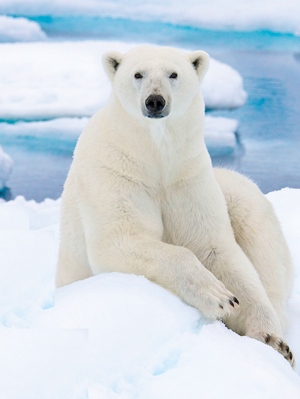 Sure, polar bears have warm fur coats. But what really helps keep them going is a thick layer of fat under the skin. A plump polar bear might have more than 4 inches of fat! Bundle up!
Sure, polar bears have warm fur coats. But what really helps keep them going is a thick layer of fat under the skin. A plump polar bear might have more than 4 inches of fat! Bundle up!  How do you keep warm outside in the winter? A down coat keeps body warmth from escaping. Arctic fox
How do you keep warm outside in the winter? A down coat keeps body warmth from escaping. Arctic fox 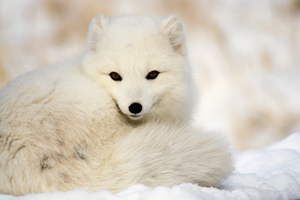 The arctic foxs fur has a soft, thick underlayer that holds warm air near the body. Musk ox
The arctic foxs fur has a soft, thick underlayer that holds warm air near the body. Musk ox 
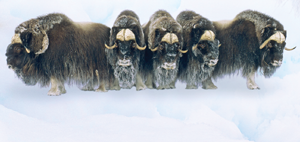 Musk oxen have long, dark hair that hangs down almost to the ground.
Musk oxen have long, dark hair that hangs down almost to the ground.
Each hair is hollow, and each little space in each hair is full of air. This helps them stay warm. Why live there? Polar animals are perfectly adapted to cold climates. The weather doesn't bother them, and they face far fewer predators than they would in other places. Slow food 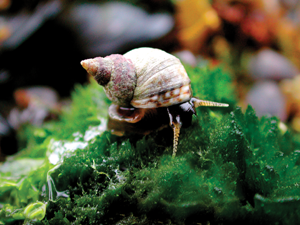 This small sea snail feeds on algae and lichen on Alaskas rocky shorelines. It moves slooowly , only about 3 feet a month.
This small sea snail feeds on algae and lichen on Alaskas rocky shorelines. It moves slooowly , only about 3 feet a month.
Fresh, not frozen 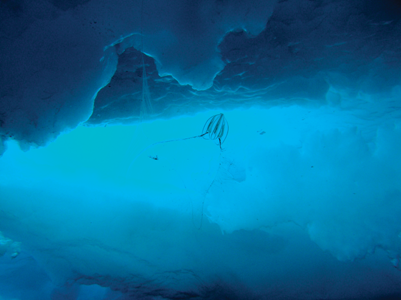 Many fish would freeze in icy polar waters, but the cold waters are home to many animals, such as the arctic cod, Greenland shark, squid, shrimp, and jellies, that can survive in cold water. Berry good!
Many fish would freeze in icy polar waters, but the cold waters are home to many animals, such as the arctic cod, Greenland shark, squid, shrimp, and jellies, that can survive in cold water. Berry good! 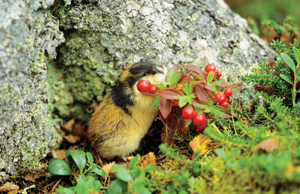 Lemmings snack on grasses, sedges, moss, and berries. But they have to be careful. All meat-eating birds and mammals in the Arctic hunt lemmings year round; they are the main meal for arctic foxes and snowy owls. Salad bar
Lemmings snack on grasses, sedges, moss, and berries. But they have to be careful. All meat-eating birds and mammals in the Arctic hunt lemmings year round; they are the main meal for arctic foxes and snowy owls. Salad bar  Plant-eating mammals like the reindeer eat greens for every meal. The tundra is home to more than 1,700 types of plant, moss, and lichen.
Plant-eating mammals like the reindeer eat greens for every meal. The tundra is home to more than 1,700 types of plant, moss, and lichen.
The big sleep 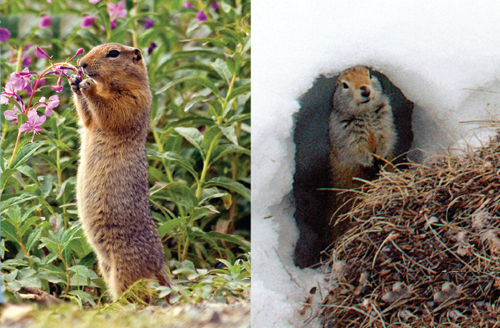 The arctic ground squirrel is the only Arctic animal that hibernatesit feasts on plants and seeds before settling into its den to sleep through the winter. This helps it save energy and survive the coldest months. Whats up, whats down? The North Pole is up. It's a point underwater in the middle of the Arctic Circle. The South Pole is down, on the continent of Antarctica.
The arctic ground squirrel is the only Arctic animal that hibernatesit feasts on plants and seeds before settling into its den to sleep through the winter. This helps it save energy and survive the coldest months. Whats up, whats down? The North Pole is up. It's a point underwater in the middle of the Arctic Circle. The South Pole is down, on the continent of Antarctica. 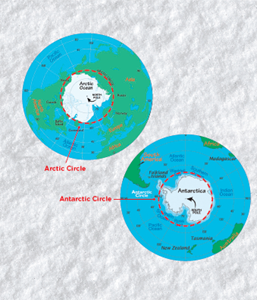 Who lives there? About 2 million people live in the Arctic Circle, mostly native peoples who live in the countries at its edge.
Who lives there? About 2 million people live in the Arctic Circle, mostly native peoples who live in the countries at its edge.  Who lives there? About 2 million people live in the Arctic Circle, mostly native peoples who live in the countries at its edge.
Who lives there? About 2 million people live in the Arctic Circle, mostly native peoples who live in the countries at its edge.
Theres no permanent population on Antarctica. Between 1,000 (winter) and 5,000 (summer) people live at research centers. 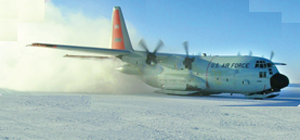 Fuel turns to slush and planes cant fly in the cold South Pole winter, making it unreachable for much of the year. That's extreme! Summer up north means it's winter down south, and vice versa. North Pole Summer 32 Winter -40 South Pole Summer -18 Winter -76 DEGREES FAHRENHEIT! Arctic Circle Many land and ocean mammals, birds, and other creatures make their homes within the Arctic Circle. Food is scarce in winter, but summer brings plentiful grasses, flowers, berries, and insects to eat.
Fuel turns to slush and planes cant fly in the cold South Pole winter, making it unreachable for much of the year. That's extreme! Summer up north means it's winter down south, and vice versa. North Pole Summer 32 Winter -40 South Pole Summer -18 Winter -76 DEGREES FAHRENHEIT! Arctic Circle Many land and ocean mammals, birds, and other creatures make their homes within the Arctic Circle. Food is scarce in winter, but summer brings plentiful grasses, flowers, berries, and insects to eat.
Only up north! 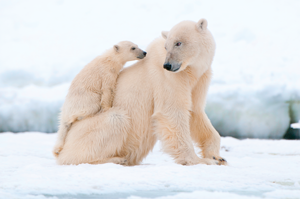 Thick fur helps keep polar bears warm.
Thick fur helps keep polar bears warm.  Snow bunting
Snow bunting 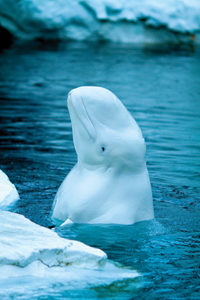 Beluga whales surface to breathe and take a look around.
Beluga whales surface to breathe and take a look around. 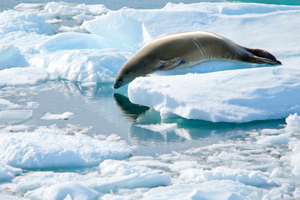 Seals search for small fish from ice floes. Antarctic Circle The South Pole has many summer visitors, but few animals can survive the harsh winters. The seawater around it freezes in winter and melts in summer, but the ice always remains frozen on Antarctica.
Seals search for small fish from ice floes. Antarctic Circle The South Pole has many summer visitors, but few animals can survive the harsh winters. The seawater around it freezes in winter and melts in summer, but the ice always remains frozen on Antarctica. 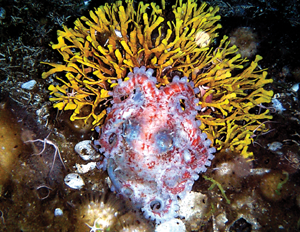 This octopus lives in the cold, deep waters around Antarctica.
This octopus lives in the cold, deep waters around Antarctica. 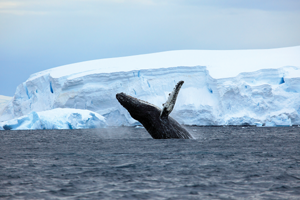 Humpback whales put on a jumping display called breaching.
Humpback whales put on a jumping display called breaching.  Humpback whales put on a jumping display called breaching.
Humpback whales put on a jumping display called breaching.
Bear necessities Polar bears can be found hanging out on the Arctic ice. Like you, the bears enjoy the sun and the water. Unlike you, they hunt for nice plump seals to eat. 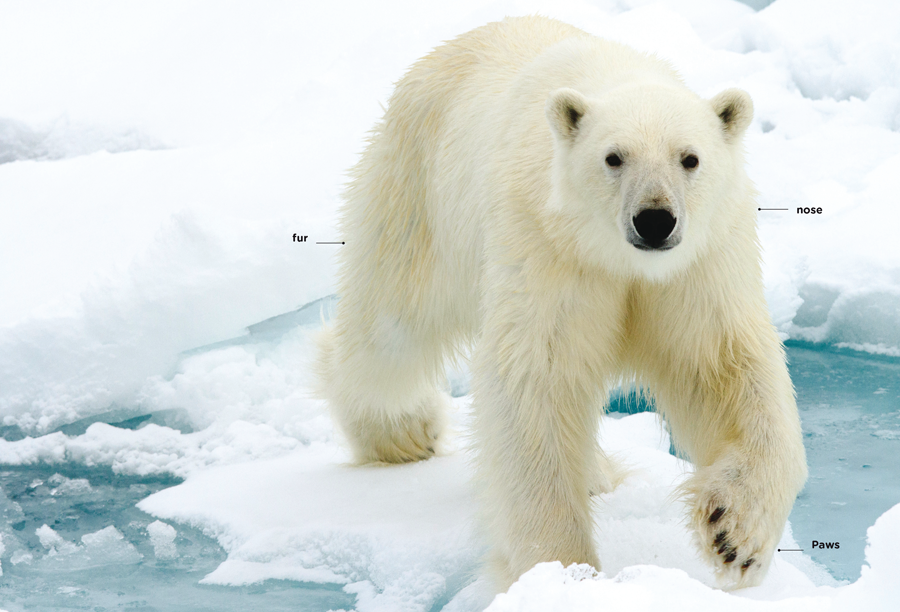 This fur is clear. The bear looks white because its coat reflects light. Its skin underneath is black, like its nose.
This fur is clear. The bear looks white because its coat reflects light. Its skin underneath is black, like its nose.
This nose knows! A polar bear has a keen sense of smell. It can smell a seal up to 20 miles away. Paws are big to help the bear swim. Front paws paddle; back paws steer. Just like me Fat under the polar bears skin keeps it warmeven more than its fur. Your bodys fat helps you stay warm, too! 
Next page
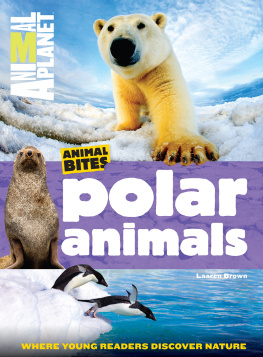


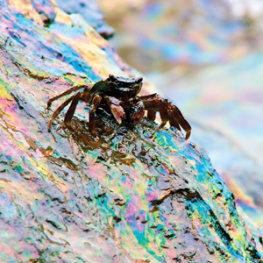


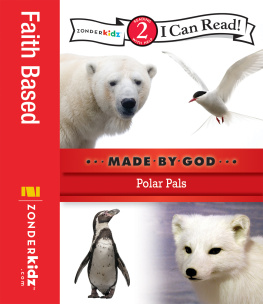



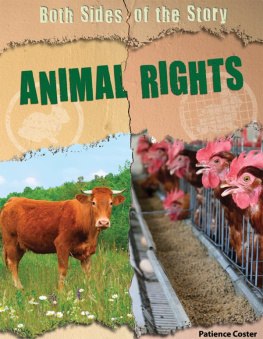



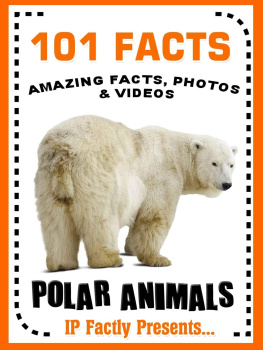
 Life in a cold climate Snowwindfreezing cold. How do animals survive the Arctic winter? Polar bear
Life in a cold climate Snowwindfreezing cold. How do animals survive the Arctic winter? Polar bear  Sure, polar bears have warm fur coats. But what really helps keep them going is a thick layer of fat under the skin. A plump polar bear might have more than 4 inches of fat! Bundle up!
Sure, polar bears have warm fur coats. But what really helps keep them going is a thick layer of fat under the skin. A plump polar bear might have more than 4 inches of fat! Bundle up!  How do you keep warm outside in the winter? A down coat keeps body warmth from escaping. Arctic fox
How do you keep warm outside in the winter? A down coat keeps body warmth from escaping. Arctic fox  The arctic foxs fur has a soft, thick underlayer that holds warm air near the body. Musk ox
The arctic foxs fur has a soft, thick underlayer that holds warm air near the body. Musk ox 
 Musk oxen have long, dark hair that hangs down almost to the ground.
Musk oxen have long, dark hair that hangs down almost to the ground. This small sea snail feeds on algae and lichen on Alaskas rocky shorelines. It moves slooowly , only about 3 feet a month.
This small sea snail feeds on algae and lichen on Alaskas rocky shorelines. It moves slooowly , only about 3 feet a month. Many fish would freeze in icy polar waters, but the cold waters are home to many animals, such as the arctic cod, Greenland shark, squid, shrimp, and jellies, that can survive in cold water. Berry good!
Many fish would freeze in icy polar waters, but the cold waters are home to many animals, such as the arctic cod, Greenland shark, squid, shrimp, and jellies, that can survive in cold water. Berry good!  Lemmings snack on grasses, sedges, moss, and berries. But they have to be careful. All meat-eating birds and mammals in the Arctic hunt lemmings year round; they are the main meal for arctic foxes and snowy owls. Salad bar
Lemmings snack on grasses, sedges, moss, and berries. But they have to be careful. All meat-eating birds and mammals in the Arctic hunt lemmings year round; they are the main meal for arctic foxes and snowy owls. Salad bar  Plant-eating mammals like the reindeer eat greens for every meal. The tundra is home to more than 1,700 types of plant, moss, and lichen.
Plant-eating mammals like the reindeer eat greens for every meal. The tundra is home to more than 1,700 types of plant, moss, and lichen. The arctic ground squirrel is the only Arctic animal that hibernatesit feasts on plants and seeds before settling into its den to sleep through the winter. This helps it save energy and survive the coldest months. Whats up, whats down? The North Pole is up. It's a point underwater in the middle of the Arctic Circle. The South Pole is down, on the continent of Antarctica.
The arctic ground squirrel is the only Arctic animal that hibernatesit feasts on plants and seeds before settling into its den to sleep through the winter. This helps it save energy and survive the coldest months. Whats up, whats down? The North Pole is up. It's a point underwater in the middle of the Arctic Circle. The South Pole is down, on the continent of Antarctica.  Who lives there? About 2 million people live in the Arctic Circle, mostly native peoples who live in the countries at its edge.
Who lives there? About 2 million people live in the Arctic Circle, mostly native peoples who live in the countries at its edge.  Fuel turns to slush and planes cant fly in the cold South Pole winter, making it unreachable for much of the year. That's extreme! Summer up north means it's winter down south, and vice versa. North Pole Summer 32 Winter -40 South Pole Summer -18 Winter -76 DEGREES FAHRENHEIT! Arctic Circle Many land and ocean mammals, birds, and other creatures make their homes within the Arctic Circle. Food is scarce in winter, but summer brings plentiful grasses, flowers, berries, and insects to eat.
Fuel turns to slush and planes cant fly in the cold South Pole winter, making it unreachable for much of the year. That's extreme! Summer up north means it's winter down south, and vice versa. North Pole Summer 32 Winter -40 South Pole Summer -18 Winter -76 DEGREES FAHRENHEIT! Arctic Circle Many land and ocean mammals, birds, and other creatures make their homes within the Arctic Circle. Food is scarce in winter, but summer brings plentiful grasses, flowers, berries, and insects to eat. Thick fur helps keep polar bears warm.
Thick fur helps keep polar bears warm.  Snow bunting
Snow bunting  Beluga whales surface to breathe and take a look around.
Beluga whales surface to breathe and take a look around.  Seals search for small fish from ice floes. Antarctic Circle The South Pole has many summer visitors, but few animals can survive the harsh winters. The seawater around it freezes in winter and melts in summer, but the ice always remains frozen on Antarctica.
Seals search for small fish from ice floes. Antarctic Circle The South Pole has many summer visitors, but few animals can survive the harsh winters. The seawater around it freezes in winter and melts in summer, but the ice always remains frozen on Antarctica.  This octopus lives in the cold, deep waters around Antarctica.
This octopus lives in the cold, deep waters around Antarctica.  Humpback whales put on a jumping display called breaching.
Humpback whales put on a jumping display called breaching.  This fur is clear. The bear looks white because its coat reflects light. Its skin underneath is black, like its nose.
This fur is clear. The bear looks white because its coat reflects light. Its skin underneath is black, like its nose.